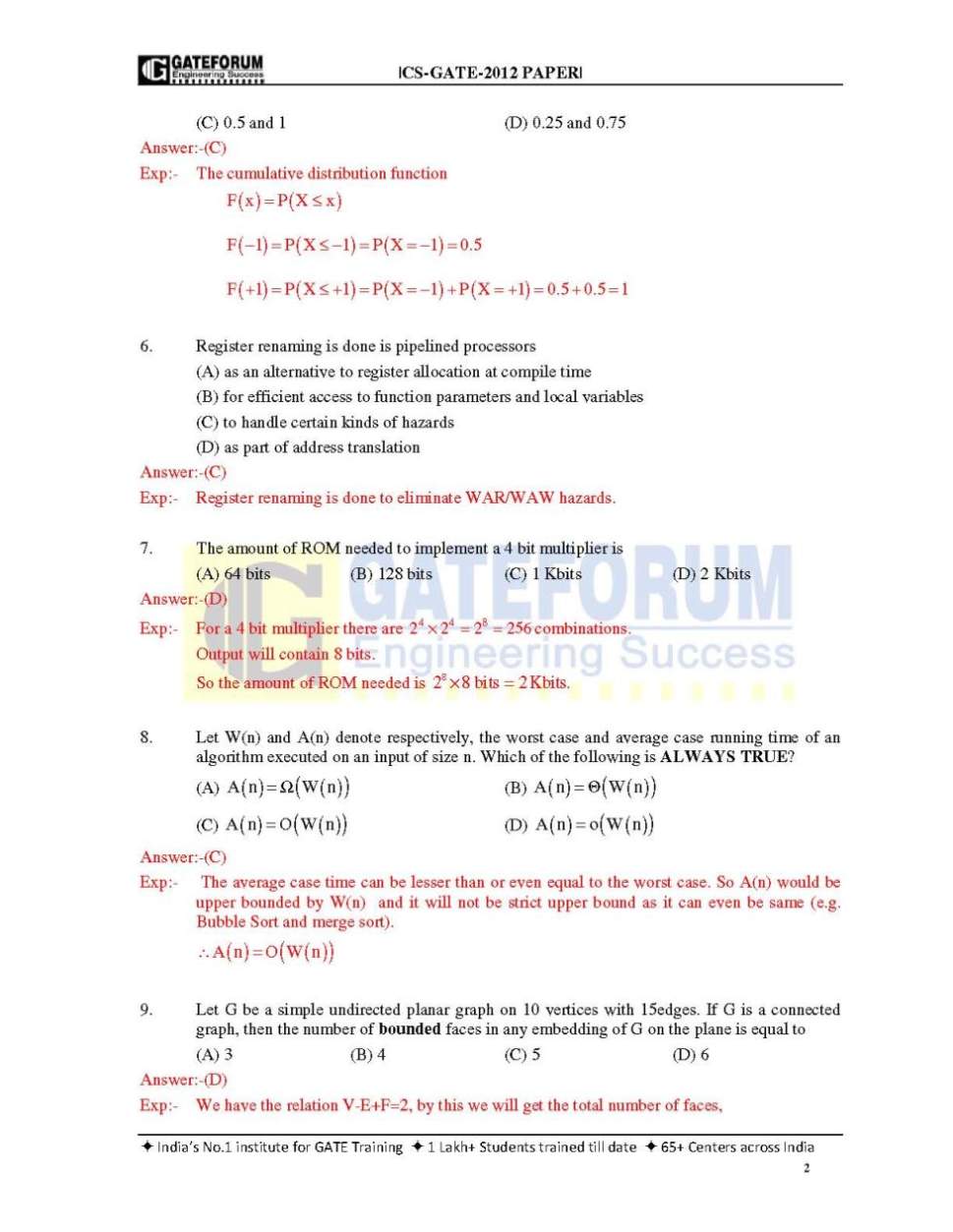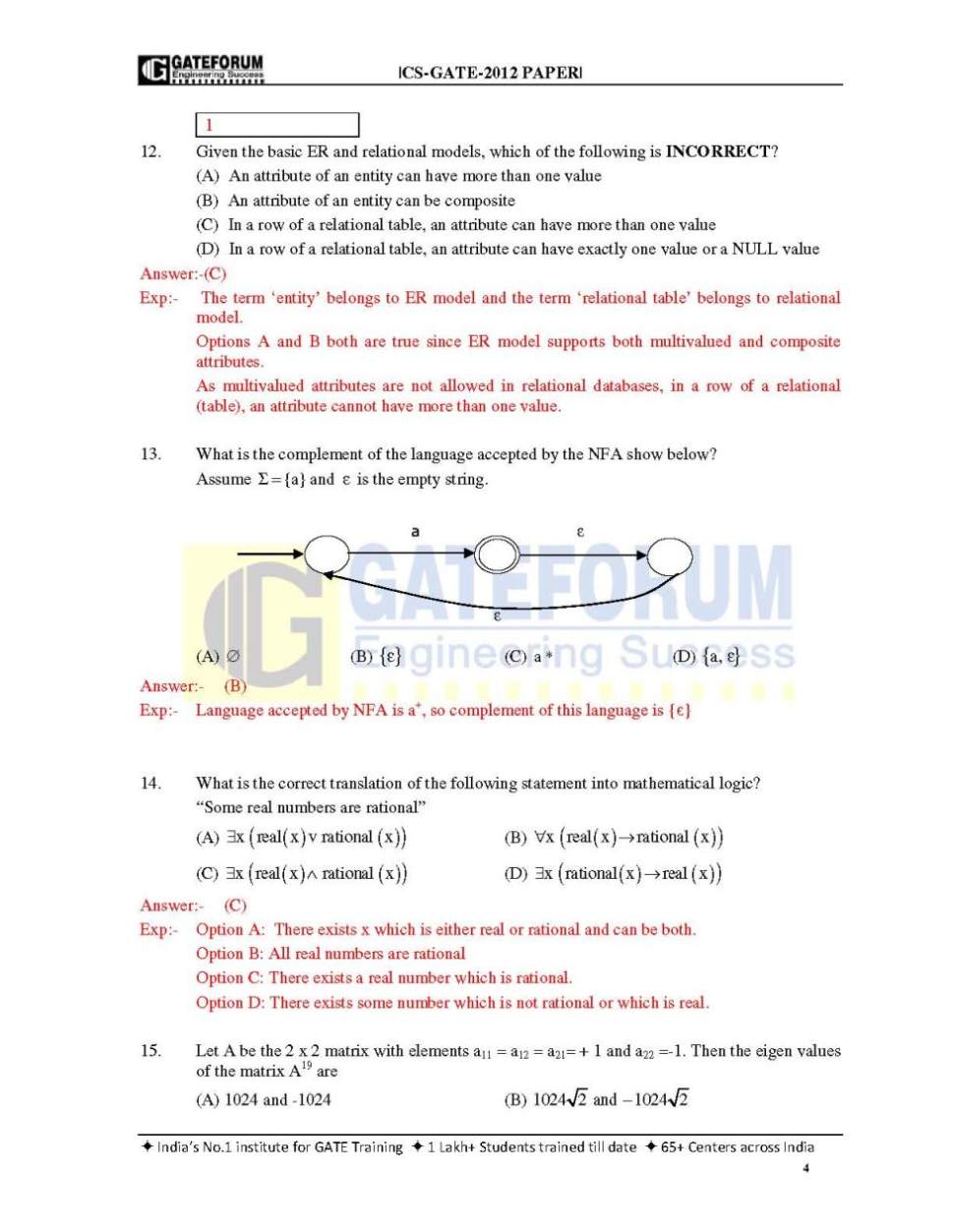|
#4
28th February 2015, 11:50 AM
| |||
| |||
| Re: Syllabus of Graduate Aptitude Test in Engineering of Computer Science and Informa
As per your request, I am forwarding you syllabus of Graduate Aptitude Test in Engineering (GATE) for Computer Science and Information Technology. Engineering Mathematics Mathematical Logic: Propositional Logic; First Order Logic. Probability: Conditional Probability; Mean, Median, Mode and Standard Deviation; Random Variables; Distributions; uniform, normal, exponential, Poisson, Binomial. Set Theory & Algebra: Sets; Relations; Functions; Groups; Partial Orders; Lattice; Boolean Algebra. Combinatorics: Permutations; Combinations; Counting; Summation; generating functions; recurrence relations; asymptotics. Graph Theory: Connectivity; spanning trees; Cut vertices & edges; covering; matching; independent sets; Colouring; Planarity; Isomorphism. Linear Algebra: Algebra of matrices, determinants, systems of linear equations, Eigen values and Eigen vectors. Numerical Methods: LU decomposition for systems of linear equations; numerical solutions of non-linear algebraic equations by Secant, Bisection and Newton-Raphson Methods; Numerical integration by trapezoidal and Simpson's rules. Calculus: Limit, Continuity & differentiability, Mean value Theorems, Theorems of integral calculus, evaluation of definite & improper integrals, Partial derivatives, Total derivatives, maxima & minima. GENERAL APTITUDE(GA): Verbal Ability: English grammar, sentence completion, verbal analogies, word groups, instructions, critical reasoning and verbal deduction. Computer Science and Information Technology Digital Logic: Logic functions, Minimization, Design and synthesis of combinational and sequential circuits; Number representation and computer arithmetic (fixed and floating point). Computer Organization and Architecture: Machine instructions and addressing modes, ALU and data-path, CPU control design, Memory interface, I/O interface (Interrupt and DMA mode), Instruction pipelining, Cache and main memory, Secondary storage. Programming and Data Structures: Programming in C; Functions, Recursion, Parameter passing, Scope, Binding; Abstract data types, Arrays, Stacks, Queues, Linked Lists, Trees, Binary search trees, Binary heaps. Algorithms: Analysis, Asymptotic notation, Notions of space and time complexity, Worst and average case analysis; Design: Greedy approach, Dynamic programming, Divide-and-conquer; Tree and graph traversals, Connected components, Spanning trees, Shortest paths; Hashing, Sorting, Searching. Asymptotic analysis (best, worst, average cases) of time and space, upper and lower bounds, Basic concepts of complexity classes P, NP, NP-hard, NP-complete. Theory of Computation: Regular languages and finite automata, Context free languages and Push-down automata, Recursively enumerable sets and Turing machines, Undecidability. Compiler Design: Lexical analysis, Parsing, Syntax directed translation, Runtime environments, Intermediate and target code generation, Basics of code optimization. Operating System: Processes, Threads, Inter-process communication, Concurrency, Synchronization, Deadlock, CPU scheduling, Memory management and virtual memory, File systems, I/O systems, Protection and security. Databases: ER-model, Relational model (relational algebra, tuple calculus), Database design (integrity constraints, normal forms), Query languages (SQL), File structures (sequential files, indexing, B and B+ trees), Transactions and concurrency control. Information Systems and Software Engineering: information gathering, requirement and feasibility analysis, data flow diagrams, process specifications, input/output design, process life cycle, planning and managing the project, design, coding, testing, implementation, maintenance. Computer Networks: ISO/OSI stack, LAN technologies (Ethernet, Token ring), Flow and error control techniques, Routing algorithms, Congestion control, TCP/UDP and sockets, IP(v4), Application layer protocols (icmp, dns, smtp, pop, ftp, http); Basic concepts of hubs, switches, gateways, and routers. Network security basic concepts of public key and private key cryptography, digital signature, firewalls. Web technologies: HTML, XML, basic concepts of client-server computing. Here, I am giving you GATE previous year paper for computer science and information technology. Q.1 Consider the following logical inferences. I1: If it rains then the cricket match will not be played. The cricket match was played. Inference: There was no rain. I2: If it rains then the cricket match will not be played. It did not rain. Inference: The cricket match was played. Which of the following is TRUE? (A) Both I and ‘2 are correct inferences (B) I is correct but 12 is not a colTect inference (C) I is not correct but ‘2 is a correct inference (D) Both I and ‘2 are not correct inferences Which of the following is TRUE? (A) Every relation in 3NF is also in BCNF (B) A relation R is in 3NF if every non-prime attribute of R is fully functionally dependent on every keyofR (C) Every relation in BCNF is also in 3NF (D) No relation can be in both BCNF and 3NF The decimal value 0.5 in IEEE single precision floating point representation has (A) fraction bits of 000.. .000 and exponent value of 0 (B) fraction bits of 000.. .000 and exponent value of—1 (C) fraction bits of 100. . .000 and exponent value of 0 (D) no exact representation A process executes the code forkO; fork(): forkO: The total number of child processes created is (A)3 (B)4 (C) 7 (D) 8 The protocol data unit (PDU) for the application layer in the Internet stack is (A) Segment (B) Datagrarn (C) Message (D) Frame Given the basic ER and relational models, which of the following is INCORRECT? (A) An attribute of an entity can have more than one value (B) An attribute of an entity can be composite (C) In a row of a relational table, an attribute can have more than one value (D) In a row of a relational table, an attribute can have exactly one value or a NULL value Which of the following statenients are TRUE about an SQL query? P : An SQL query can contain a HAVING clause even if it does not have a GROUP BY clause Q: An SQL query can contain a HAVING clause only if it has a GROUP BY clause R: All attributes used in the GROUP BY clause must appear in the SELECT clause S : Not all attributes used in the GROUP BY clause need to appear in the SELECT clause (A) P and R (B) P and S (C) Q and R (D) Q and S Which of the following problems are decidable? 1) Does a given program ever produce an output? 2) If L is context-free language, then, is L also context-free? 3) If L is regular language, then, is L also regular? 4) If L is recursive language, then, is L also recursive? (A) 1,2,3,4 (B) 1,2 (C) 2,3,4 (D) 3,4 Given the language L-{ab, aa, baa}, which of the following strings are in L*? 1) abaabaaabaa 2) aaaabaaaa 3) baaaaabaaaab 4) baaaaabaa (A) 1,2 and 3 (B) 2,3 and 4 (C) 1,2 and 4 (D) 1,3 and 4       For complete question paper consider the attachment. |